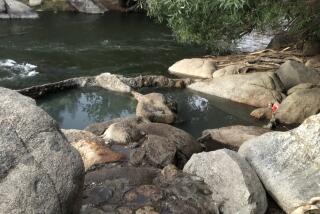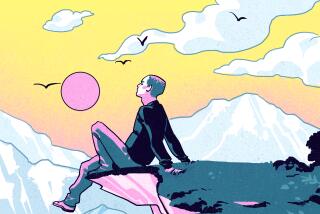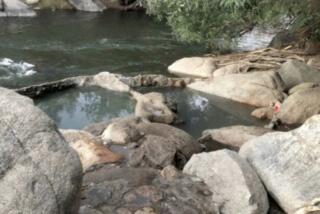Legendary Waters : With Matilija Spa Up for Auction, Patrons Hope Indian Magic Will Hold
- Share via
On a sheer cliff high above Matilija Hot Springs in the Ojai Valley, a lone white cross stands silhouetted against the evening sky.
Some say that the Chumash Indian chief Matilija is buried here and that his spirit wanders the vale at night, searching for a lost daughter and protecting the sulfur hot asprings that bear his name.
“When the Spanish came to Ventura and built the mission, they kept exploring here and became convinced that the Indians were guarding gold. But perhaps they were just guarding these life-saving waters,” said 66-year-old Bill Olivas, a former wrestler and gentle Buddha of a man who, with his wife, Martha, has managed Matilija since 1965.
As Olivas recounts the legend of Matilija from a massage room inside the cabin-like spa, the slow, solemn drip of water onto rock punctuates his words. From cloistered rooms, unseen, gurgling pipes carry a mantra to those who seek the spring’s soothing warmth.
$300,000 Minimum Bid
Patrons hope that the spirit of Matilija will continue to protect the hot springs in February, when Ventura County puts the 9.5-acre property on the auction block at a minimum bid of $300,000. The county has owned the natural spa since 1947, when it purchased the land for the Matilija Dam project.
But the dam’s waters failed to inundate the site, so the county, which maintains that it never intended to enter the mineral-bath business, eventually leased the property to Olivas. Today, flagging business has put Olivas $50,000 behind on his rent, and the county has opted out, saying that it wants to sell its small parcels of open space and concentrate on developing large regional parks.
Olivas, in turn, says he is ready to retire after years of managing a relaxing but less-than-lucrative venture. He traces his financial woes to the steep cost of liability insurance and a 1985 forest fire that closed the springs and caused extensive damage.
The Ventura County Board of Supervisors on Tuesday formally decided to sell the hot springs. However, because zoning prevents new development at the site, the next owner will probably spruce up Matilija and continue operating it as a spa.
Ted Nauman, a Ventura marketing consultant interested in buying the business for a group of investors he declined to name, calls it “an under-utilized wilderness attraction.” County officials say they have had almost 20 inquiries.
Like many spots where hot water bubbles up from the earth, Matilija has long been considered by many to be a magical place.
The past doubles back on itself here in strange and mysterious ways. How else to explain the fact that Olivas, whose Mexican great-grandfather may have battled Chumash Indians near this spot, now tends the waters and stokes the legend of the dead Indian chief Matilija?
Centuries before the Spanish stumbled upon the Ojai Valley, the Chumash built lodges here and immersed themselves in the mineral springs for religious ritual and purification.
Ojai historical records show that the Chumash did not live at Matilija proper but camped near Meiners Oaks, three miles to the south, and posted guards along the trails that led to the sacred waters. Alternating between steam baths and icy plunges in nearby streams, Chumash males underwent rites of passage and prowess here. Women remained at home.
Then came the Spanish, who established the San Buenaventura Mission in 1782 under Father Junipero Serra and whose soldiers soon began exploring as far inland as Ojai. Olivas’ great-grandfather, Raimundo Olivas, was one of the garrison soldiers who served the Mexican government and was rewarded with a land grant for a 4,700-acre rancho near the Santa Clara River, according to Ventura historian Judith Triem.
In the 1840s, the former soldier built the Olivas Adobe, now a state historic landmark.
Ventura historian E. M. Sheridan has written that, in 1824, the Chumash Indians attacked Spanish soldiers at San Buenaventura Mission. One tale has it that the Indians were avenging the Spanish extermination of an Indian settlement in the Sulfur Mountains near Ojai, but historians have been unable to document that.
By legend, Chief Matilija led the attack, in part to rescue his daughter Amatil, who was being held at the mission against her will. The chief wrested his daughter from Spanish hands, but soldiers pursued the Indians to the mouth of Matilija Canyon, where Amatil’s lover, Olana, was mortally wounded.
Crazed with grief, Amatil broke into tears and eventually also died--of a broken heart. According to the story, everywhere her tears fell, there bloomed a pure white poppy that has become known as the Matilija poppy.
In another version, Chief Matilija--in loneliness and despair at finding his daughter dead--jumped to his own death from the rock just below Matilija Springs. His remains are said to be buried at the white cross, and Olivas says that, each spring, the star-shaped Matilija poppy blooms on his grave.
Although the romantic tale of Matilija may be legend, history records that the the Chumash, by the late 1800s, had dwindled in the face of disease and forced labor at the missions.
Meanwhile, in 1872, Ojai resident J. W. Wilcox “discovered” Matilija Hot Springs and sold it to an entrepreneur who built several cottages there and operated it as a curative mineral bath, according to Ojai historian Patricia L. Fry.
A flood destroyed the resort in 1884, but Abram Blumberg homesteaded the land three years later, pitched some tents and opened the resort anew.
Blumberg advertised Matilija boldly, asserting that the 104-degree sulfur springs were “the finest known and cure the following diseases: Rheumatism, Catarrh, Erysipelas, Sore Eyes, Dyspepsia, Chronic Diarrhea, Liver and Kidney Complaint, La Grippe, Neuralgia, Piles, Cancer, Syphilis and all kinds of Blood and Skin Diseases.”
Individual springs had names like “The Fountain of Life,” “Mother Eve” and “Jacob’s Well.”
People flocked to the curative sensation.
By 1893, Blumberg’s spa could accommodate 100 guests at a time, and he was shipping Matilija water as far as New York, Fry wrote in her history of the Ojai Valley.
Visitors came up from the Ojai and Ventura train depots in four-horse stagecoaches. One of the stage drivers was Bill Olivas’ father. Olivas himself recalls splashing around in the pools of Matilija as a child.
Between 1900 and 1947, when Ventura County acquired the property, the hot springs changed hands often and underwent many renovations. One owner added an outdoor swimming pool. Another built bungalows, a restaurant and a bar. Someone planted orange, eucalyptus and palm trees that remain today.
Then came Bill Olivas in the mid-1960s, an Ojai native who had spent 25 years on the international pro-wrestling circuit and wanted to give his bones a break. Olivas says he wrestled in some of the first televised matches in New York’s Madison Square Garden and Chicago’s Marigold Gardens. But Olivas didn’t wrestle under his real name--his manager thought it was too tame a moniker for exhibition wrestling.
So Olivas, who came from one of Ventura County’s founding families, let his hair grow into an Afro and became known as “The Elephant Boy.”
“My manager wanted to give me some glamour,” Olivas recalls a bit sheepishly.
After breaking a leg during a match, Olivas and his wife became interested in the healing powers of massage and hydrotherapy and began taking classes. Both became accredited by the American Massage and Therapy Assn.
Olivas then worked for a time as a masseur in Hot Springs, Ark., and Warm Springs, Ga.--where President Franklin D. Roosevelt went for therapy to ease the effects of polio.
Eventually, the Olivas moved back to Ojai. When they spotted a story in the local paper saying that the county wanted to lease Matilija, they jumped at the opportunity.
Under the Olivas’ management, the hot springs have been known as a relaxed spot that is short on amenities and polish but long on rustic appeal. The overnight cottages are gone. The restaurant and bar are closed. The pool with its two big slides is empty and drained. Olivas charges $5 for a 30-minute dip in one of his four hot-spring tubs and $35 for an hour massage--a little less pricey than the more elegant and upscale Wheeler Hot Springs near Ojai, which features a gourmet restaurant and Sunday hot-tub brunches.
While he awaits his springs’ last rites, Olivas still gets up every morning around 5 a.m. to turn on the pump that pipes the hot mineral water into his tubs from the source about 600 yards up the canyon.
“I’m the first one to take a dip each morning,” he says.
In the right light, the sulfur mist rising from the still pools sometimes look like wispy Indian smoke signals.
To Olivas, that’s not so unusual.
“The spirit of Matilija still looks after these waters,” he said.
More to Read
Sign up for Essential California
The most important California stories and recommendations in your inbox every morning.
You may occasionally receive promotional content from the Los Angeles Times.










